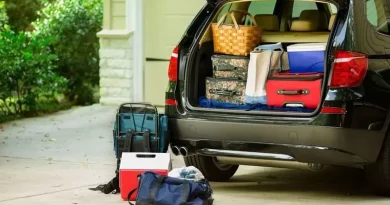Pack Like a Pro: Space-Saving Tips and Road Trip Essentials
Embarking on a road trip is an exciting adventure that promises freedom, exploration, and unforgettable memories. However, ensuring a smooth and enjoyable journey requires careful planning, especially regarding packing. This becomes even more worthwhile when you are traveling with family or friends and need to take a lot of things in limited vehicles.
Whether you’re a seasoned road tripper or a first-timer, mastering the art of packing efficiently can significantly impact your overall experience. In this guide, we’ll delve into road trip essentials and space-saving tips to help you pack like a pro.
Space-Saving Tips
While packing the right essentials is necessary, you should also consider the space in your car. You don’t want to make it uncomfortable for your sitting. Hence, there’s also a need to save some space so that you can pack as many essentials as possible.
Rooftop Cargo Bags and Compression Bags
According to RoofPax, rooftop cargo bags offer a practical solution, efficiently utilizing the often-underutilized roof space of your car. These bags are designed to be securely attached to the roof, providing a weather-resistant and spacious storage option.
One of the key advantages of rooftop cargo bags is their ability to accommodate a significant amount of gear, luggage, or equipment. This particularly benefits those going on a long trip with bulky items such as camping gear, sports equipment, or extra luggage.
Moreover, people traveling in groups can make the most of rooftop bags. These bags will store most of the items to give maximum seating space for travelers. This will eliminate the need for making adjustments and ensure a comfortable journey.
The bags come in various sizes, allowing you to choose one that suits your specific needs and the size of your vehicle. A RoofPax cargo bag, for example, comes in 15, 19, and 23 cubic feet sizes. Moreover, they are made of waterproof materials so you don’t have to worry even in rain.
You can also efficiently organize your clothing and maximize space in your luggage by using compression bags. They are another excellent option for saving space, allowing you to squeeze the air from bulky items like jackets or blankets. According to TravelingLight, compression packing cubes compress clothes by 25-30%.
Multi-Functional Gear
Opt for multi-functional items to minimize the number of things you need to pack. For example, a convertible backpack that can be used as a daypack or a beach bag can save space and serve multiple purposes.
Consider collapsible and stackable cookware, which not only saves precious storage space but also provides versatile cooking options. These space-saving cooking sets typically include pots, pans, and utensils that can be neatly nested together, reducing the footprint in your vehicle.
Another space-efficient solution is a convertible sleeping system. Instead of bulky sleeping bags and separate air mattresses, opt for multi-functional sleeping pads that can be transformed into compact chairs. This dual-purpose gear ensures you have a comfortable place to rest at night without sacrificing seating during the daytime.
Road Trip Essentials
Road trips have become very popular, thanks to the adventure and exploration they offer. In fact, an article from Globe Newswire states that 43% of American homes chose road trips among other forms of travel in 2023. But not all these rides go as planned. Here are some packing essentials you need for a mesmerizing road trip.
Comfortable Clothing and Footwear
When embarking on a road trip, choosing clothing and footwear is pivotal in ensuring comfort and practicality throughout the journey. Opt for loose, breathable fabrics that accommodate the fluctuations in temperature that often accompany diverse landscapes.
Layers are key, allowing you to adjust to varying climates as you traverse different regions. Consider packing a mix of short and long-sleeved shirts and a lightweight jacket or sweater for cooler evenings.
Comfortable footwear is paramount for long hours spent behind the wheel and impromptu explorations. Select shoes that provide support and ease for both driving and walking. Sneakers or comfortable walking shoes ensure you can seamlessly transition from the driver’s seat to stretching your legs during rest stops. Sturdy and comfortable hiking boots might be worthwhile if you plan on engaging in outdoor activities, such as hiking or sightseeing.
Navigation Tools
Smartphones have become an essential tool for GPS navigation. Whenever someone is in doubt about how to reach a destination, he or she simply gets directions on Google Maps. Statista surveyed 9,564 individuals to determine how many people use phones to get directions. The study revealed that 37% of respondents between 18 and 29 used their cell phones for maps or GPS navigation.
While smartphones have become indispensable for navigation, it’s wise to have a backup plan. Bring physical maps or a GPS device, especially if traveling through areas with spotty cell reception. This ensures you stay on course even when technology fails.
Entertainment and Connectivity
The right entertainment can make long hours on the road more enjoyable. Bring a variety of music playlists, podcasts, audiobooks, and games. Music often serves as the heartbeat of any journey, and creating a carefully curated playlist can set the mood for the entire adventure.
With the prevalence of streaming services, having access to a diverse range of music is easily achievable. However, it’s also wise to download favorite tracks in areas with limited connectivity.
To capture and immortalize moments along the way, a camera is a valuable travel companion. Whether it’s a dedicated camera or your smartphone, having the ability to document scenic landscapes contributes to the overall narrative of your road trip.
Consider a portable phone charger or power bank to keep your devices charged, ensuring you’re always connected and entertained. Consider how many charging cycles your power bank provides before taking one on the trip. Taking this factor into account will ensure quick charging when required. According to These Gadgets, most power banks deliver up to 500 charging cycles.
First-Aid Kits
A thoughtfully assembled first-aid kit offers reassurance and practical solutions for unforeseen health-related situations. Within this essential kit, basic medical supplies serve as the frontline defense against minor injuries and ailments. Bandages, gauze, and adhesive tapes cater to cuts, grazes, and other superficial wounds, providing a quick and effective means of first aid.
Antiseptic wipes or solutions prevent infection, offering a hygienic solution to cleanse wounds before applying dressings. Pain relievers, such as acetaminophen or ibuprofen, address common discomforts like headaches or muscle soreness, ensuring a more comfortable journey.
Motion sickness medication can be a valuable addition, especially if your road trip involves winding or uneven roads. Carrying any necessary prescription medications is paramount, ensuring continuity of treatment throughout the journey. It’s wise to include various bandage sizes and shapes to accommodate different injuries and a pair of tweezers for safely removing splinters.
In conclusion, packing for a road trip requires a thoughtful balance between essential items and space-saving strategies. You can streamline your packing by incorporating these road trip essentials and space-saving tips into your planning process. Remember, the key is to strike the right balance between preparedness and flexibility, allowing you to embrace spontaneity and adventure. So, pack like a pro, hit the road, and savor the freedom of the open highway.




